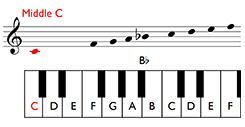5.5 Semitones and tones and the scale of F major
So far, the scales we have discussed have, apart from C major, included notes prefaced by sharps. However, if we start a scale on notes different from those we’ve already tried, the generating pattern T T S T T T S can involve the use of flats instead of sharps. You’ll remember that a sharpraises a note by a semitone; conversely, a flat, shown by the symbol, ♭ , lowers a note by a semitone. As with the sharp sign, #, the flat sign, ♭, is written before the note to which it applies, and is placed on the same line or in the same space as the note head. Both sharps and flats are called accidentals and will be covered in more detail in Section 6.
Here is the series of notes generated if we start on F:
| F–G | Tone |
| G–A | Tone |
| A–B♭ | Semitone |
| B♭–C | Tone |
| C–D | Tone |
| D–E | Tone |
| E–F | Semitone |
Here, the only note that is different from those in C major is the B♭. (C major has B.) But B♭ was necessary here because the third interval in the T T S T T T S pattern is a semitone, not a tone, and therefore the note a semitone below B is required, i.e. B♭, not B. On a keyboard, as you can see from Example 46, this is the black note set back between A and B.
Example 46

You may have wondered why one black note is a sharp (as we saw with F♯) and another is a flat, the B♭. The answer is that notes on a keyboard can be called different things depending on their context. Major (and, as we shall see, minor) scales are seven-note (heptatonic) scales, and each note has a different letter name. Thus, the seven letter names in F major are F G A B(♭) C D E. They are not called F G A A(♯) C D E, because this would mean A comes twice and there is no B. On the keyboard, then, B♭ and A♯ are the same note, but when writing the scale of F major, B♭ is used, not A♯.
